Immerse yourself in the vibrant world of water birds in Washington, where diverse species call the state’s lush, aquatic habitats their home. Washington’s vast waterways, from the Pacific coastline to the serene inland lakes and rivers, play host to a colorful palette of avian life.
Washington water birds
| Water Bird Species | Frequency in Washington | Specific Locations in Washington |
|---|---|---|
| American White Pelican | Common | Columbia River, McNary National Wildlife Refuge |
| Brown Pelican | Common | Coastal areas like Cape Flattery |
| Double-Crested Cormorant | Common | Puget Sound, Columbia River |
| Great Blue Heron | Very Common | Throughout the state, particularly in wetlands |
| Great Egret | Common | Lower Columbia River, Nisqually National Wildlife Refuge |
| Snowy Egret | Less Common | Nisqually National Wildlife Refuge |
| Green Heron | Common | Throughout the state in wetland areas |
| Black-Crowned Night-Heron | Uncommon | Lower Columbia River, Nisqually National Wildlife Refuge |
| Mallard | Very Common | Statewide in various habitats, from urban parks to wetlands |
| Wood Duck | Common | Throughout the state, particularly in wooded swamps |
| Blue-Winged Teal | Common | Eastern Washington, especially wetlands |
| Northern Pintail | Common | Eastern Washington, especially wetlands |
| Redhead | Less Common | Eastern Washington, McNary National Wildlife Refuge |
| Ring-Necked Duck | Common | Statewide, especially in freshwater ponds |
| Bufflehead | Common | Throughout the state, especially in inland waters |
| Hooded Merganser | Common | Statewide, particularly in forested wetlands |
| Common Merganser | Common | Throughout the state, particularly in large lakes and rivers |
| Ruddy Duck | Less Common | Eastern Washington, particularly at Turnbull National Wildlife Refuge |
| American Coot | Very Common | Statewide, especially in marshes and open water |
| Sandhill Crane | Less Common | Eastern Washington, especially at Creamer’s Field Migratory Waterfowl Refuge |
| American Wigeon | Common | Throughout the state, particularly in open water |
| Osprey | Common | Throughout the state, especially near large bodies of water |
| Common Loon | Less Common | Northern Washington, especially in Ferry County |
| Pied-Billed Grebe | Common | Throughout the state, especially in marshes and ponds |
| American Bittern | Less Common | Eastern Washington, especially at Turnbull National Wildlife Refuge |
| Marbled Murrelet | Less Common | Western Washington, particularly in old-growth forests and nearshore waters |
Water Bird Species Found in Washington
American White Pelican


| Feature | Measurement |
|---|---|
| Scientific Name | Pelecanus erythrorhynchos |
| Length | 50–70 in |
| Wingspan | 95–120 in |
| Weight | 3.5 and 13.6 kg |
The American White Pelican (Pelecanus erythrorhynchos) is one of North America’s largest birds, distinguished by its brilliant white plumage, elongated orange bill, and massive wingspan, which can extend up to 3 meters. This bird has a unique appearance with its distinctive pouch used for feeding and a “horn” on the upper part of the bill during the breeding season. Though a large bird, it is very graceful in flight, often seen soaring in flocks in a V formation.
American White Pelicans inhabit lakes, marshes, and salt bays, and despite their size, they are excellent swimmers. They feed primarily on fish, using a cooperative hunting strategy where they encircle schools of fish in shallow water and then scoop them up in their bill pouches. Unlike their brown pelican relatives, they do not dive for their food. During the breeding season, these pelicans will nest in colonies on islands in freshwater lakes.
Brown Pelican (Pelecanus occidentalis)
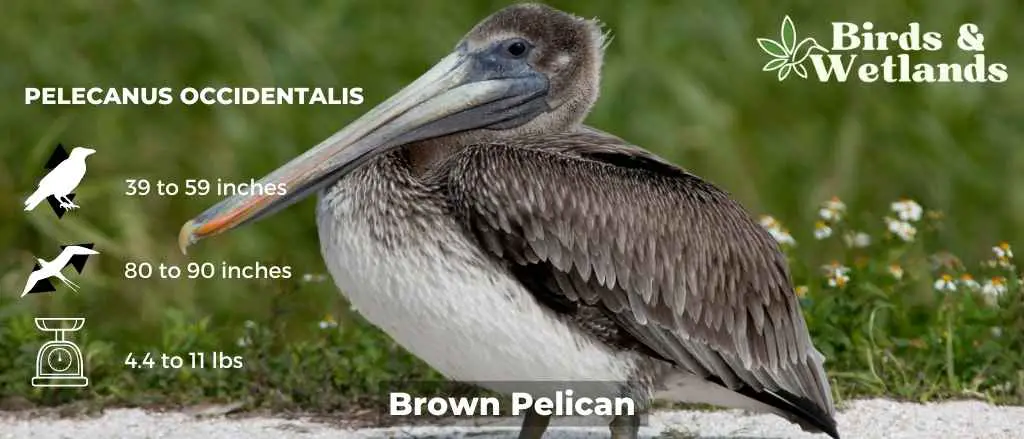
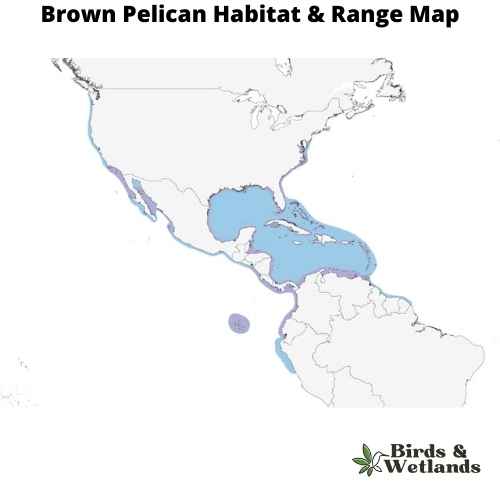
Listen:
Scientific Name: Pelecanus occidentalis
Length: 3 ft 3 in to 5 ft 0 in
Wingspan: 6 ft 8 in to 7 ft 6 in
Weight: 4.4 to 11.0 lb
The Brown Pelican is a large water bird famous for its distinct body shape and dramatic feeding habits. Known for their habit of diving headfirst into the water to catch fish, they are a staple along the coasts of the southern United States.
Appearance: Brown Pelicans are easily identifiable due to their long, curved necks, stout bodies, and large bills with a stretchy pouch. As their name suggests, they have brown and gray body feathers, with a paler head and neck that can become yellowish in breeding season.
Diet: Their diet mainly consists of fish, which they catch by making spectacular plunging dives from the air, scooping up the fish in their expandable bill pouches. They then drain the water from their pouches before swallowing their catch.
Reproduction: Brown Pelicans nest in colonies on islands, laying 2 to 3 eggs in nests made from sticks and vegetation. Both parents share incubation and feeding duties. After hatching, the chicks remain in the nest for around 12 weeks before they are ready to leave.
Double-crested cormorant

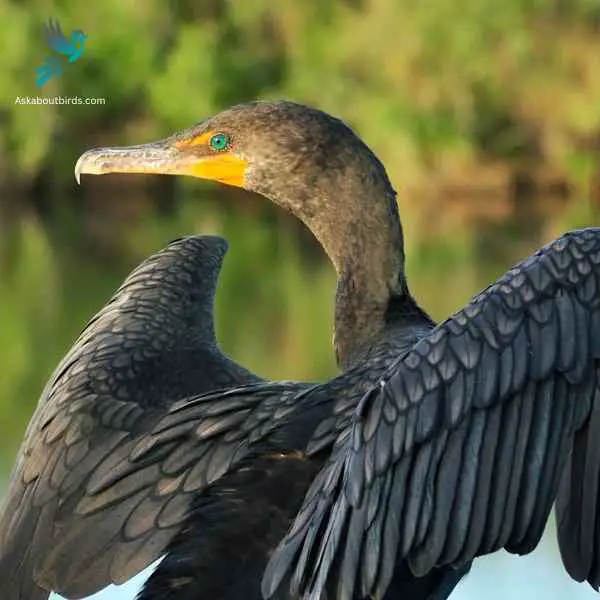
| Feature | Measurement |
|---|---|
| Scientific Name | Nannopterum auritum |
| Length | 28–35 in |
| Wingspan | 45–48 in |
| Weight | 1.2–2.5 kg |
The Double-Crested Cormorant (Phalacrocorax auritus) is a large waterbird known for its long neck, hooked bill, and almost entirely black body. The species gets its name from the two small patches of tufted feathers or “crests” found on the heads of breeding adults, one on each side. These birds are strong swimmers that propel themselves underwater with their webbed feet, their bodies submerged and necks above the water surface, giving them a characteristic snake-like appearance when swimming.
Double-Crested Cormorants are widely distributed across North America and can be found in a variety of aquatic environments including freshwater lakes, coastal areas, and rivers. Their diet primarily consists of fish, which they catch by diving from the water’s surface. Often seen perched with wings outstretched to dry after fishing, these cormorants nest in trees, on the ground, or on cliff edges, usually in colonies. While they have rebounded from decreases in the mid-20th century due to DDT-related reproductive failures, they face ongoing threats from habitat loss, entanglement in fishing gear, and conflicts with fisheries over their consumption of fish. Protection and careful management of their habitats are key to their ongoing conservation.
Great Blue Heron


| Feature | Measurement |
|---|---|
| Scientific Name | Ardea herodias |
| Length | 36–54 in |
| Wingspan | 66–79 in |
| Weight | 1.82–3.6 kgs |
Great Blue Herons are the largest heron species in North America, is distinguished by its tall stature and unique blue-gray plumage.
Measuring up to 4.5 feet tall with a wingspan of approximately 6.5 feet, the bird features a long, pointed bill, a white head with a black eye stripe extending to slender black plumes, and robust, elongated legs. Its distinctive flight pattern, forming a tight “S” shape with its neck, sets it apart from similar large birds, like cranes.
Inhabiting various wetland habitats, including marshes, lakes, rivers, and coastal regions throughout much of North and Central America, the Great Blue Heron is a wading bird. Often seen poised statue-like at the water’s edge, these birds are expert hunters, spearing fish and capturing small animals with their sharp bills.
Great Egret


| Feature | Measurement |
|---|---|
| Scientific Name | Ardea alba |
| Length | 31 to 41 in |
| Wingspan | 52 to 67 in |
| Weight | 1.5 to 3.3 lbs |
The Great Egret (Ardea alba), also known as the Common Egret, is a large, elegant wading bird recognized for its brilliant white plumage, slender black legs, and long, dagger-like yellow bill.
With a height of up to 3.3 feet and a wingspan of 52 to 67 inches, this bird is amongst the largest of the heron species. Its stately appearance and serene comportment have made it a popular symbol in many cultures and an eye-catching sight in its habitats.
Found across all continents except Antarctica, the Great Egret resides in both fresh and saltwater wetlands, including marshes, ponds, and coastal areas. It feeds mainly on fish, but it also hunts amphibians, small mammals, and invertebrates.
Snowy Egret

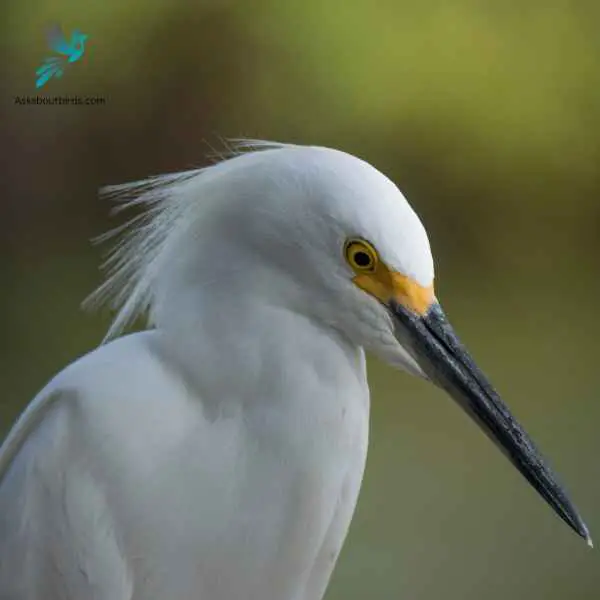
| Feature | Measurement |
|---|---|
| Scientific Name | Egretta thula |
| Length | 22.1–26.0 in |
| Wingspan | 39.4 in |
| Weight | 370 g |
The Snowy Egret (Egretta thula) is a small and active wading bird, celebrated for its delicate beauty. It sports an entirely white plumage that appears to glow against its black bill and legs, and striking yellow feet, which often play a crucial role in luring prey during feeding.
The Snowy Egret is further adorned with fine, plume-like feathers on its head, neck, and back during the breeding season, making it one of the more distinctive heron species.
Inhabiting wetland areas across the Americas, the Snowy Egret can be found in marshes, swamps, shorelines, and tidal flats where it feeds primarily on fish, but also consumes insects, crustaceans, and small reptiles.
Green Heron

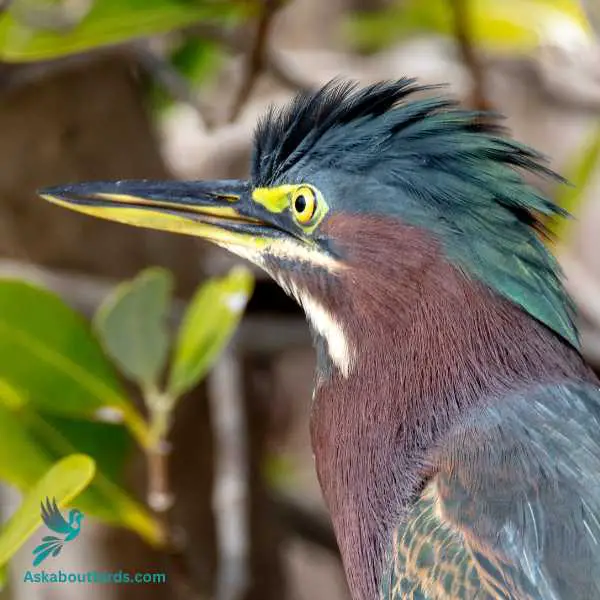
| Feature | Measurement |
|---|---|
| Scientific Name | Butorides virescens |
| Length | 16-18 inches |
| Wingspan | 25-27 inches |
| Weight | 6-7 ounces |
The Green Heron is a small heron found in North America, notable for its deep green back and chestnut body, as well as its unique fishing tactics.
Appearance: Green Herons are dark and compact birds with a glossy, greenish-black cap, a greenish back and wings, and chestnut neck and belly. The bill is long, dark and sharply pointed. Their legs are bright orange or yellow. Young birds are duller in color, with a dark top and streaked brown front.
Diet: The Green Heron’s diet is quite varied, consisting mostly of small fish, but also includes insects, spiders, and sometimes amphibians and small mammals. It’s known for its tool-using behavior where it drops bait onto the water’s surface to attract fish.
Reproduction: Green Herons are solitary birds except during the breeding season, where they form monogamous pairs. Nests are typically built in trees or shrubs near water. Females lay 2 to 5 pale blue-green eggs that both parents incubate.
Black-Crowned Night-Heron
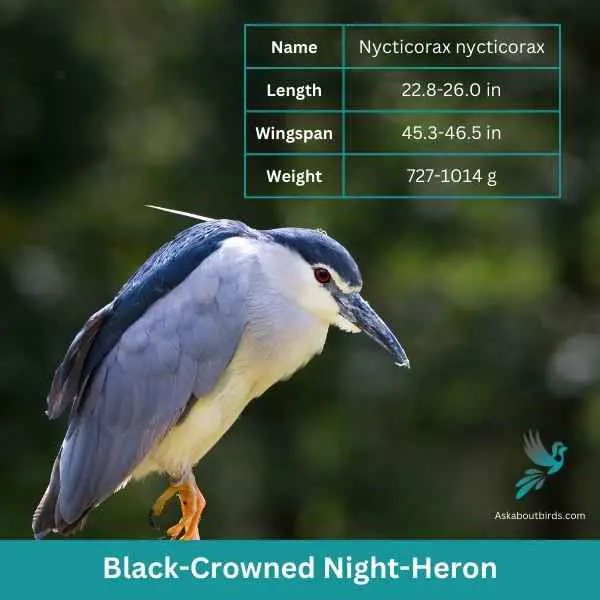
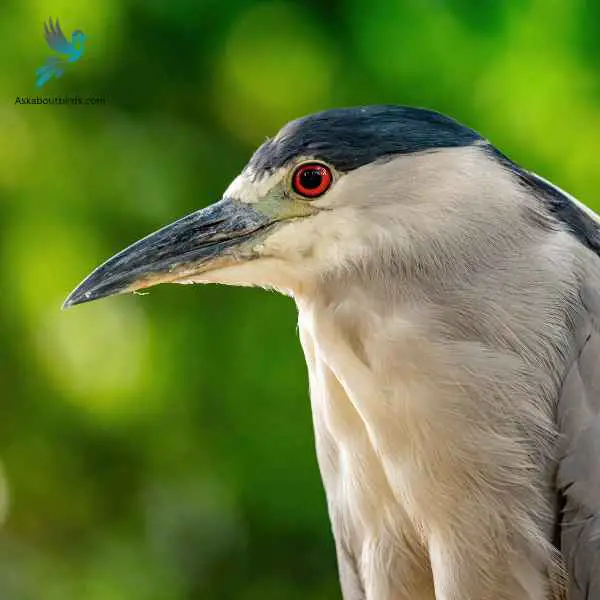
| Feature | Measurement |
|---|---|
| Scientific Name | Nycticorax nycticorax |
| Length | 22.8-26.0 in |
| Wingspan | 45.3-46.5 in |
| Weight | 727-1014 g |
The Black-Crowned Night-Heron (Nycticorax nycticorax) is a medium-sized heron species known for its distinct nocturnal habits and characteristic appearance. The bird displays a stocky silhouette, with a black crown and back, contrasting starkly with its light grey wings and white underparts.
Its eyes are large and red, adapted for its night-time activities, and its legs are relatively short for a heron. The bill is sturdy and black, and during the breeding season, two to three long white plumes extend from the back of the head.
Residing in a wide variety of wetland habitats, from freshwater marshes to coastal regions, the Black-Crowned Night-Heron is found across a large global range, including the Americas, Europe, Asia, and Africa. The species primarily feeds on fish and invertebrates, but it is known to be opportunistic and will also eat small mammals, birds, and eggs.
Mallard

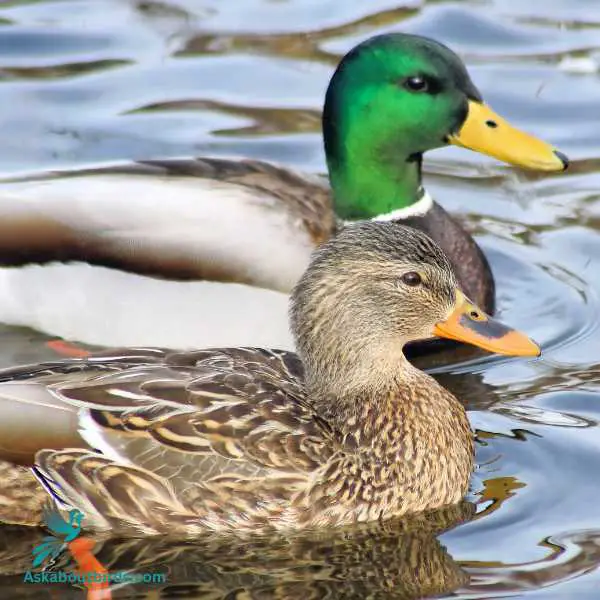
| Feature | Measurement |
|---|---|
| Scientific Name | Anas platyrhynchos |
| Length | 20-26 inches |
| Wingspan | 32-39 inches |
| Weight | 1.6-3.5 pounds |
The Mallard, one of the most recognizable of all ducks, is distinguished by its classic “quack” and its common presence in city parks and wild wetlands.
Appearance: Mallards are large ducks with a hefty body and rounded head. The male is notable for its glossy green head, gray body, and black tail-curl, while the female is mottled brown with an orange-brown bill. Both sexes have a white-bordered, blue “speculum” patch in the wing.
Diet: Mallards are omnivorous, dabbling ducks that eat a wide variety of foods. They are known to feed on aquatic vegetation, insects, worms, and grains. In city parks, they are often seen eating bread, popcorn, and other food provided by humans, although such items are not part of their natural diet.
Reproduction: Mallards nest on the ground on dry land that is close to water, under cover of tall grass or other vegetation. The female typically lays around 8 to 13 eggs and incubates them herself.
Wood Duck
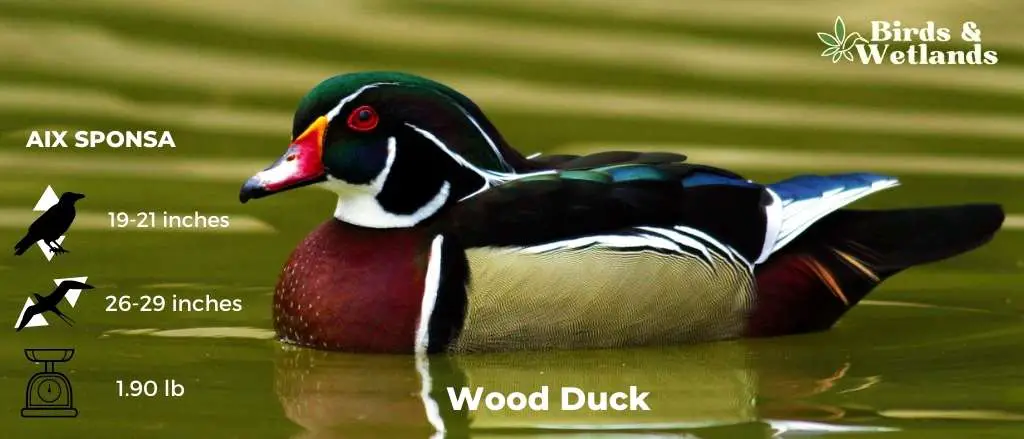
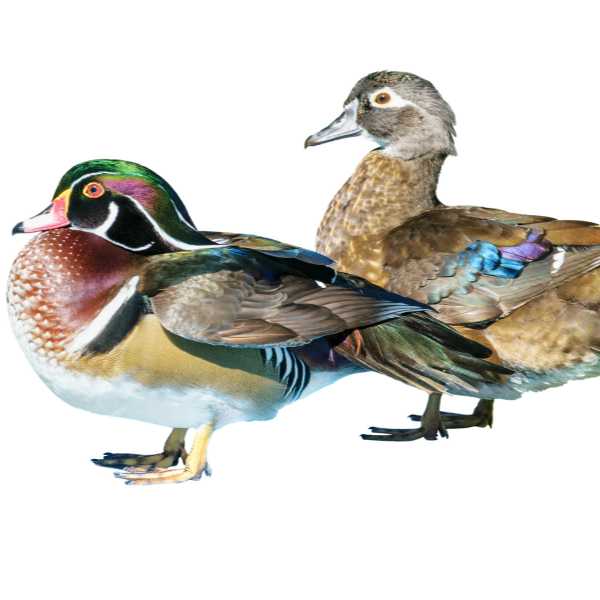
Listen:
Scientific Name: Aix sponsa
Length: 19 to 21 in
Wingspan: 26 to 29 in
Weight: 16.0-30.4 oz
The Wood Duck is an exquisitely colorful waterfowl known for its unique nesting habits and is commonly seen in wooded swamps, marshes, and streams across North America.
Appearance: With their dazzling plumage, Wood Ducks are among the most stunning birds. Males display a multitude of colors, including a green and purple crested head, red eyes, and a white-striped chest, all contrasted with a bronze-colored body. Females, though more subdued with a gray-brown body and white eye-ring, also possess their own charm.
Diet: Wood Ducks have a diverse diet that includes seeds, fruits, and insects, as well as other invertebrates. Their broad diet helps them to adapt to a variety of habitats, whether in the wild or in urban areas with suitable nesting sites.
Reproduction: Unlike most other ducks, Wood Ducks prefer to nest in tree cavities near water, leading to their common name. They will also readily use nest boxes if they’re available. A typical clutch consists of 9 to 14 eggs, which the female incubates alone.
Blue-winged Teal
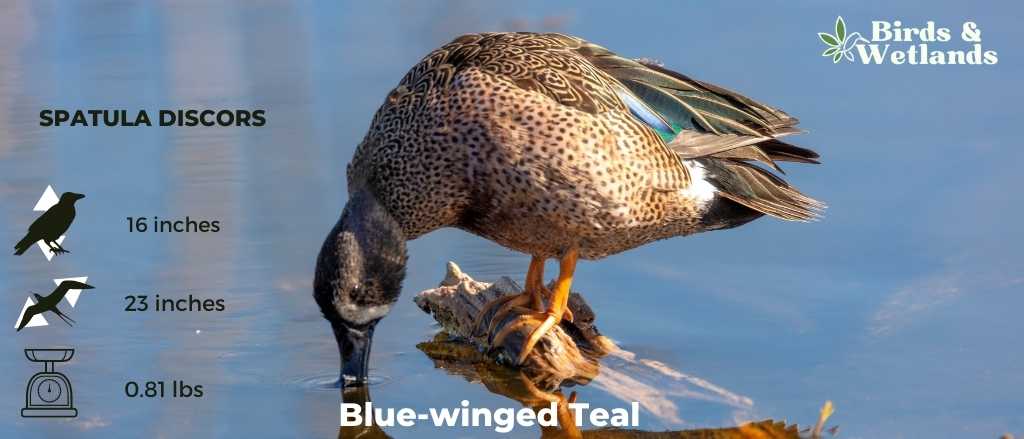
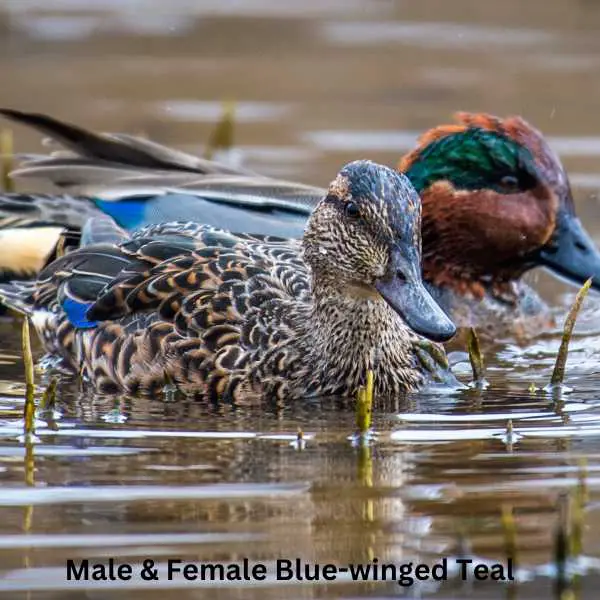
Listen to Blue-winged Teal
Scientific Name: Spatula discors
Length: 16 in
Wingspan: 23 in
Weight: 13 oz
The Blue-winged Teal is a small species of dabbling duck known for its striking plumage and its extensive migratory habits.
Appearance: Male Blue-winged Teals are quite colorful, with a slate gray head and neck, a white crescent in front of the eyes, and a predominantly brown body with specks of black. The name “Blue-winged” comes from the patch of blue feathers visible on their wings during flight. Females, in contrast, are primarily brown and subtly mottled to provide camouflage.
Diet: The Blue-winged Teal feeds mainly on plant matter, such as seeds and aquatic vegetation. However, they also supplement their diet with small invertebrates, especially during the breeding season. They are known for their “dabbling” behavior, where they feed at the surface of the water rather than diving.
Reproduction: Blue-winged Teals prefer to nest on the ground in grassy areas near water. The female typically lays a clutch of 9 to 13 eggs, which she incubates alone for about three weeks. After hatching, the ducklings can feed themselves but remain under the mother’s protection until they are capable of flying.
Northern Pintail
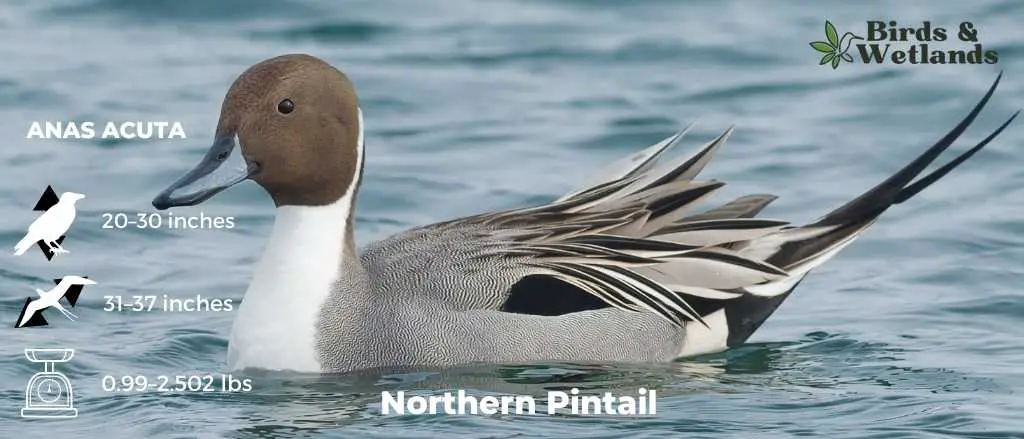
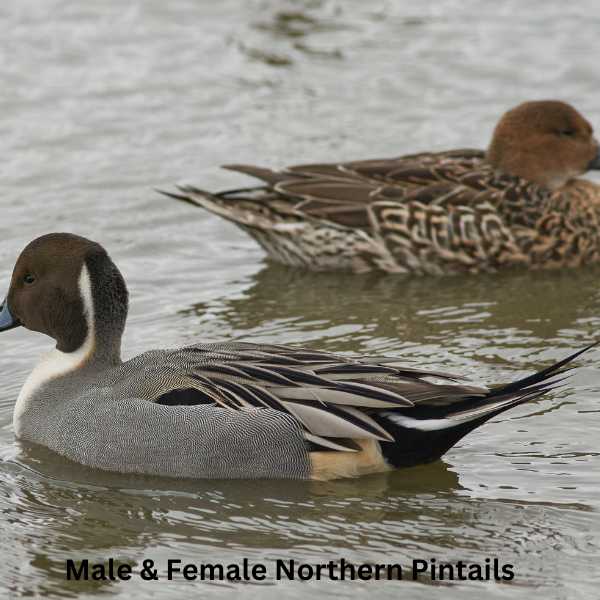
Listen to Northern Pintail
Scientific Name: Anas acuta
Length: 23–30 in
Wingspan: 31–37 in
Weight: 1 –3 lb
The Northern Pintail is a graceful species of duck recognized for their elegance in flight and their sleek bodies and long tails which is pin-shaped.
Male Northern Pintails are celebrated for their distinctive appearance, featuring a chocolate brown head, a white neck, and a grayish body. The most notable characteristic is the long, pointed tail feathers, which give this species its name. Females are more understated in color, sporting a mottled brown plumage.
Diet: Consists primarily of plant matter, including seeds and aquatic vegetation. They are also known to eat insects, especially during the breeding season. The Northern Pintail is often seen dabbling and upending in water bodies to forage for food.
Reproduction: Northern Pintails usually nest on the ground, near water bodies. The female lays a clutch of 7 to 9 eggs and is solely responsible for their incubation, which lasts for about three weeks.
Redhead
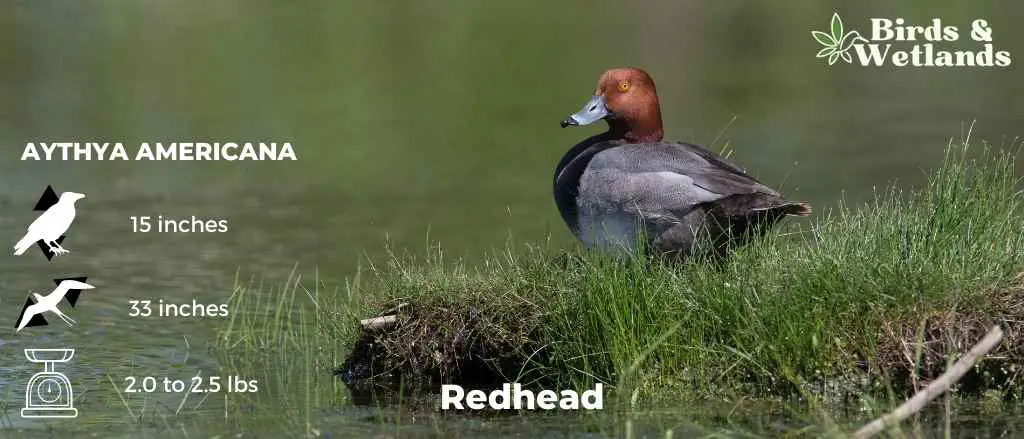

Listen
Scientific Name: Aythya americana
Length: 15 in
Wingspan: 33 in
Weight: 2.0 to 2.5 lbs
The Redhead is a medium-sized diving duck species recognized by its rounded head and broad blue bill. This bird is frequently found in wetlands, ponds, and open water bodies across the United States.
Appearance: The male Redhead is particularly striking, characterized by a coppery red head, black breast, and a gray body. The female is less colorful, featuring a brownish body and a duller, brownish-red head. Both sexes have a prominent blue bill with a black tip.
Diet: Redheads feed on a variety of items, including aquatic plants, seeds, and tubers. They also consume aquatic invertebrates, particularly during the breeding season.
Reproduction: Redheads often nest in marshes and ponds with dense vegetation.Females often lay their eggs in the nests of other ducks, a phenomenon known as brood parasitism. When nesting themselves, the female typically lays a clutch of 7 to 10 eggs and incubates them for about three weeks.
Ring-necked Duck (Aythya collaris)
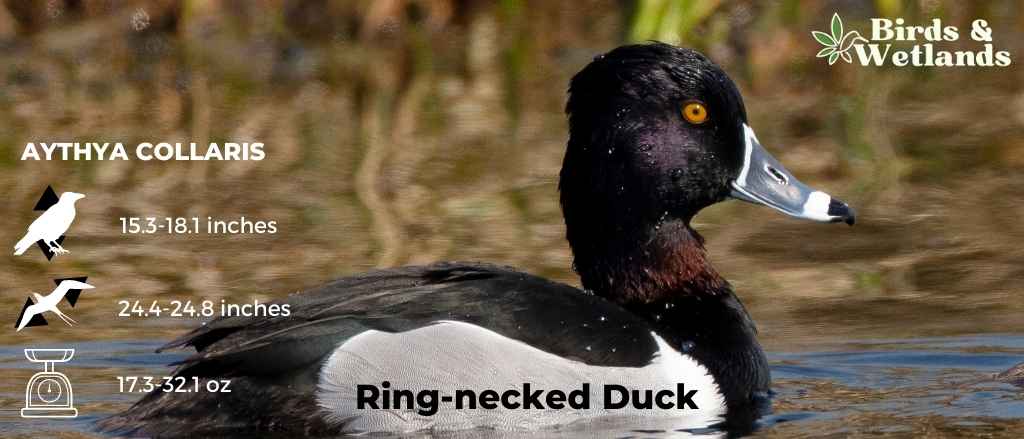

Listen
Scientific Name: Aythya collaris
Length: 15.3-18.1 in
Wingspan: 24.4-24.8 in
Weight: 17.3-32.1 oz
The Ring-Necked Duck is a small to medium-sized diving duck known for its distinctive markings and agile diving abilities.
Appearance: Male Ring-Necked Ducks are characterized by their bold black-and-white coloration, with a glossy black back, a striking white ring around the base of the bill, and two white “rings” on their flanks. Despite their name, the chestnut-colored ring around their neck is often hard to see. Females are more subtly colored with a gray-brown body and a white eye-ring.
Diet: These ducks have a varied diet that includes aquatic plants, seeds, and invertebrates, which they obtain by diving underwater in both shallow and deep water bodies.
Reproduction: The Ring-Necked Duck nests near water, often in densely vegetated areas. The female typically lays between 8 to 10 eggs, which she incubates alone, but both parents will care for the ducklings once they hatch.
Bufflehead

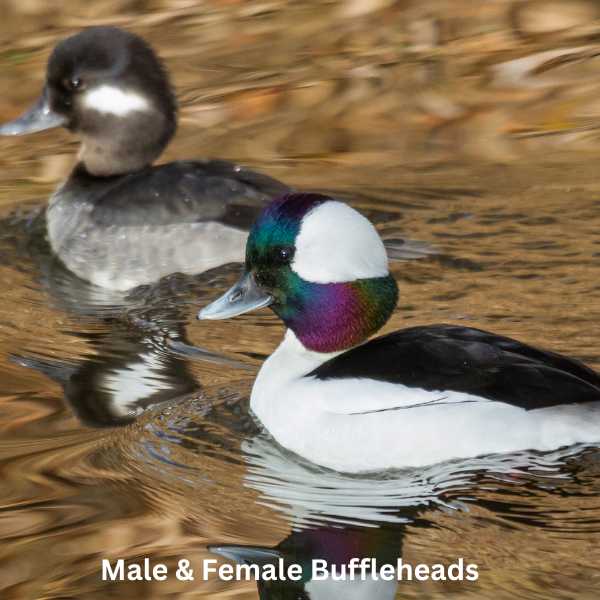
Listen to Bufflehead
Scientific Name: Bucephala albeola
Length: 13–16 in
Wingspan: 21.6 in -23.2 in
Weight: 9.5–19.4 oz
The Bufflehead is a small, compact species of diving duck known for its striking appearance and large heads and unique nesting habits.
Appearance: Male Buffleheads are easily recognized by their large, bulbous head with a green-purple iridescent sheen, a large white patch across the back of the head, and a predominantly black and white body. Females are more subtly colored, primarily in gray-brown tones with a smaller white cheek patch.
Diet: As diving ducks, Buffleheads feed by diving beneath the water’s surface. Their diet consists largely of aquatic invertebrates, such as insects, crustaceans, and mollusks, as well as some plant matter.
Reproduction: Uniquely among ducks, Buffleheads often nest in tree cavities, especially those made by Northern Flickers, a type of woodpecker. The female lays a clutch of about 6 to 11 eggs, which she incubates alone for roughly a month.
Hooded Merganser
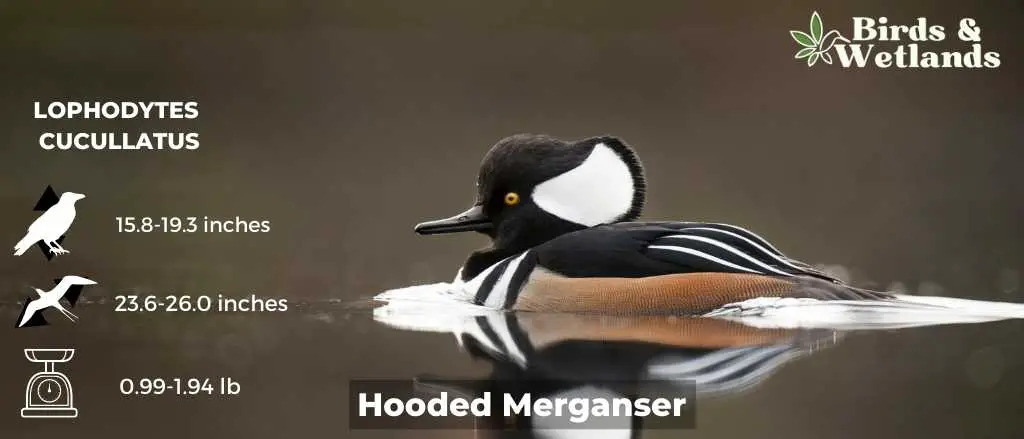
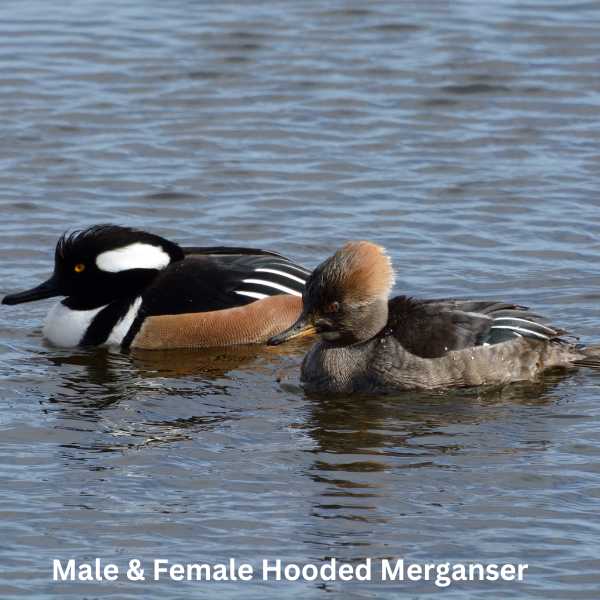
Listen to Hooded Merganser
Scientific Name: Lophodytes cucullatus
Length: 15.8-19.3 in
Wingspan: 23.6-26.0 in
Weight: 16.0-31.0 oz
The Hooded Merganser is a distinctive species of diving duck known for its showy crest and its excellent diving skills.
Appearance: Male Hooded Mergansers are especially striking with a large, fan-shaped, black and white crest, which can be expanded or contracted. They have bright yellow eyes, a dark back, and a white chest. The females have a more understated appearance with a brownish body, a smaller, reddish-brown crest, and dark eyes.
Diet: Consists of small fish, aquatic insects, and crustaceans. Their eyes are specially adapted for underwater vision, allowing them to spot and catch prey while diving.
Reproduction: Similar to Buffleheads, Hooded Mergansers often nest in tree cavities near water bodies. The female lays a clutch of about 10 to 12 eggs and incubates them alone for about a month.
Common Merganser
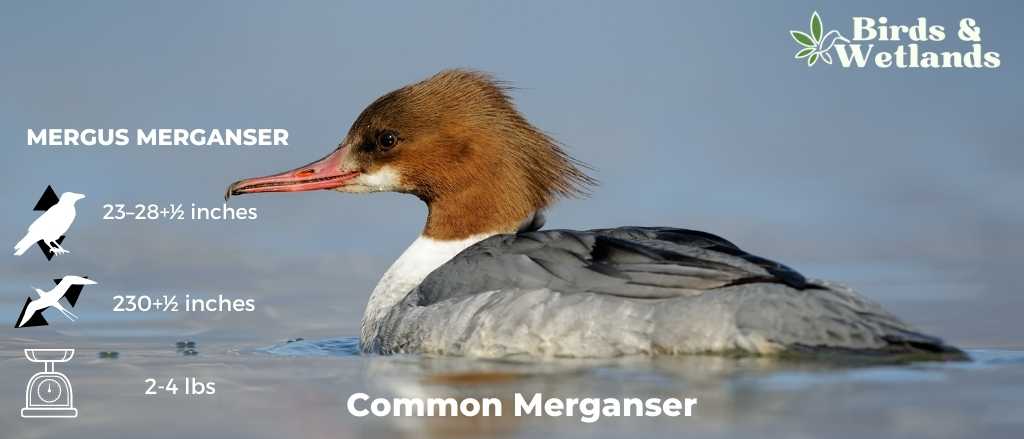
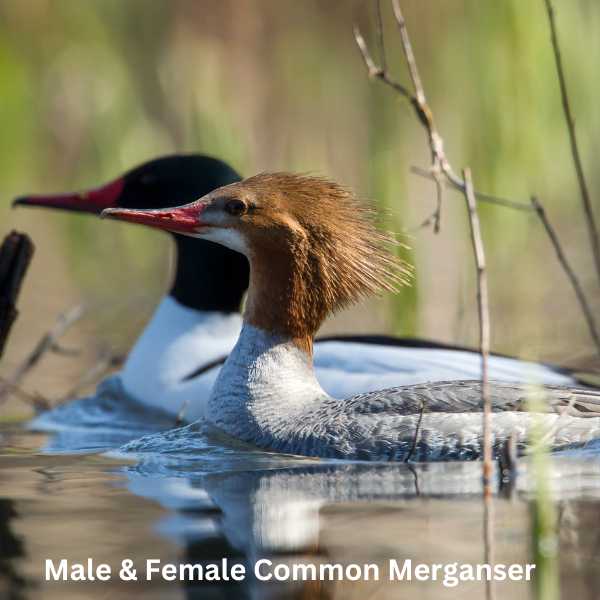
Listen:
Scientific Name: Mergus merganser
Length: 23–28 in
Wingspan: 30 – 38 in
Weight: 2 lb 0 oz – 4 lb 10 oz
The Common Merganser is a large and elegant diving duck, famous for its unique fishing abilities and seen often in the lakes, rivers, and coastal areas across North America.
Appearance: The male Common Merganser is quite striking with its dark green, almost black, crested head, bright red bill, and white body tinged with salmon-pink. The females have a reddish-brown crested head, a white neck, and a grayish body, but share the same red bill as the males.
Diet: True to their diving duck status, Common Mergansers are exceptional hunters, primarily feeding on fish. They’re also known to consume aquatic invertebrates and, on occasion, small mammals and birds. Their serrated bills are specialized to hold slippery fish tightly.
Reproduction: Like the Wood Duck, Common Mergansers also nest in tree cavities or nest boxes close to water bodies, but can also use rock crevices or holes in the ground. A clutch usually contains 9 to 12 eggs, incubated solely by the female.
Ruddy Duck
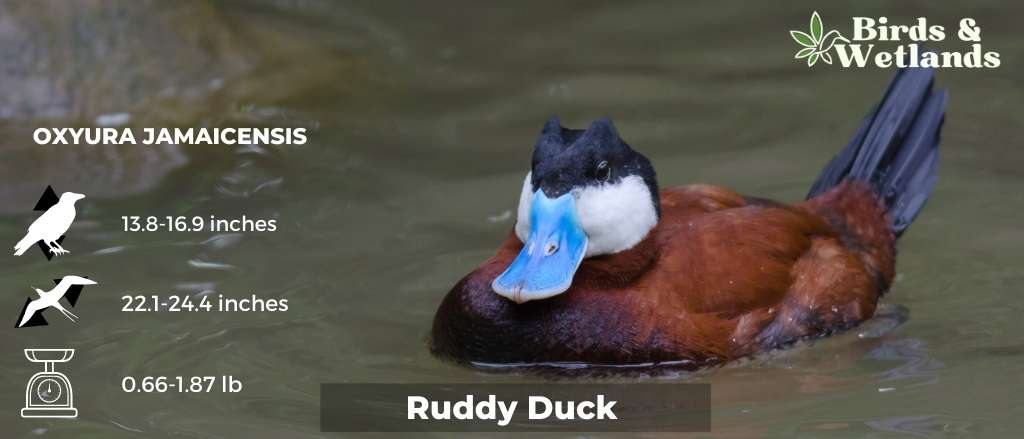
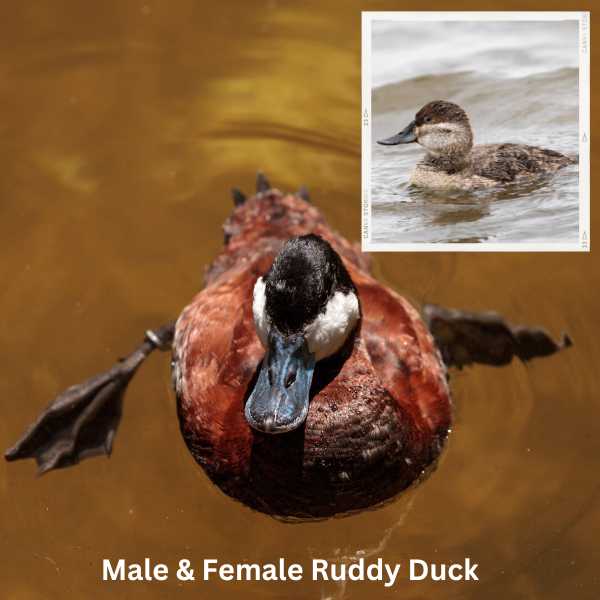
Listen
Scientific Name: Oxyura jamaicensis
Length: 13.8-16.9 in
Wingspan: 22.1-24.4 in
Weight: 10.6-30.0 o
The Ruddy Duck is a compact diving duck species recognized for its bright blue bill and stiff tail that is often held upright. These small, agile birds are found in wetlands and ponds across the United States.
Appearance: Ruddy Ducks are characterized by their distinct reddish-brown plumage, a blackish cap and nape, and a strikingly blue bill in males. The females are less vibrant, with gray-brown feathers and a dark bill. Both genders display a unique, spiky tail that often sticks upright, especially during courtship displays.
Diet: Ruddy Ducks primarily feed on a diet of aquatic invertebrates such as insects, crustaceans, and mollusks. They also consume a variety of aquatic plants and seeds. Their specialized bill allows them to sift through the water and mud to find food.
Reproduction: Ruddy Ducks nest in marshes and ponds with dense vegetation. The female typically lays a clutch of 6 to 10 eggs in a well-concealed nest built from plant material and down.
American Coot
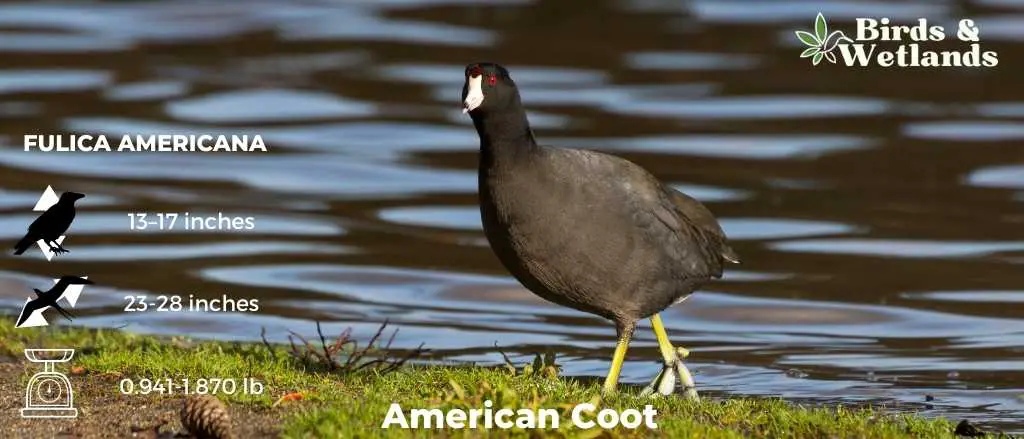
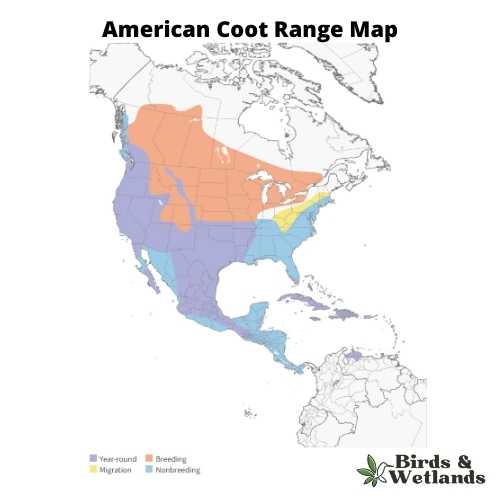
Listen:
Scientific Name: Fulica americana
Length: 13–17 in
Wingspan: 23 to 28 in
Weight: 1.270 to 1.870 lb
The American Coot is a ubiquitous water bird commonly seen in the wetlands, lakes, and ponds of North America, recognized for its adaptability and striking features.
Appearance: American Coots are easily identifiable by their slate-gray bodies, offset by a white, chicken-like bill and a red eye. Their legs are also distinctive, equipped with lobed toes, as opposed to the webbed feet seen in ducks, which assist them in navigating both land and water adeptly.
Diet: While aquatic plants form the bulk of an American Coot’s diet, they aren’t strictly herbivores. These versatile birds also consume small invertebrates and fish, demonstrating their ability to adapt and survive in a variety of habitats.
Reproduction: Nesting for the American Coot usually happens in shallow water bodies, where they construct a floating nest hidden among the vegetation. A clutch can contain between 8 to 12 eggs, all of which are incubated by both parents.
Sandhill Crane
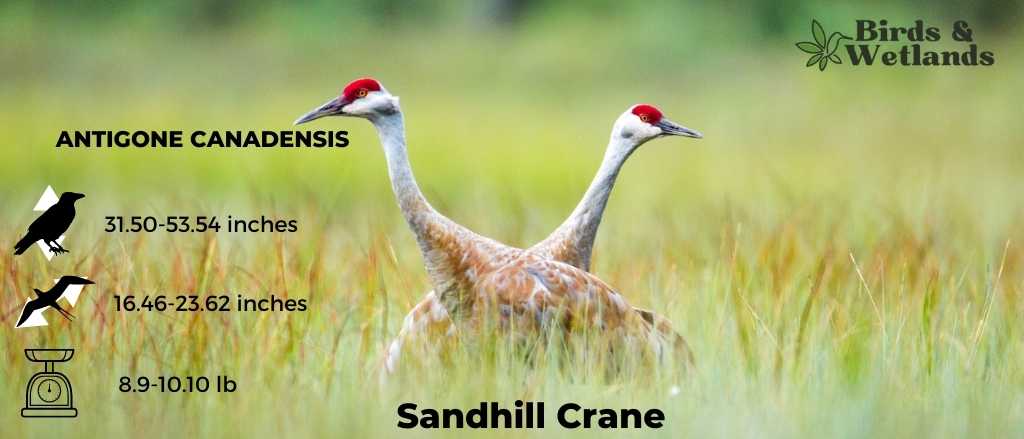

Listen:
Scientific Name: Antigone canadensis
Length: 2 ft 7-4 ft 6 in
Wingspan: 16.5–23.6 in
Weight: 4 – 4.5 kg
The Sandhill Crane is a tall, elegant bird known for its impressive size and striking appearance. They are found across North America, in habitats ranging from wetlands to grasslands.
Appearance: Sandhill Cranes are recognized for their tall stature, gray body, long legs, and long neck. Their most distinctive feature is a red forehead, which contrasts with their otherwise primarily gray plumage. During the breeding season, their gray feathers often take on a rusty-brown hue due to them rubbing iron-rich mud onto their feathers.
Diet: Sandhill Cranes are omnivorous birds and their diet is quite diverse, consisting of seeds, grains, berries, insects, small mammals, reptiles, and amphibians. They are known to forage while walking in shallow water or in fields.
Reproduction: Sandhill Cranes mate for life and their complex courtship dance is a sight to behold. They nest in marshy areas and the female typically lays two eggs.
American Wigeon
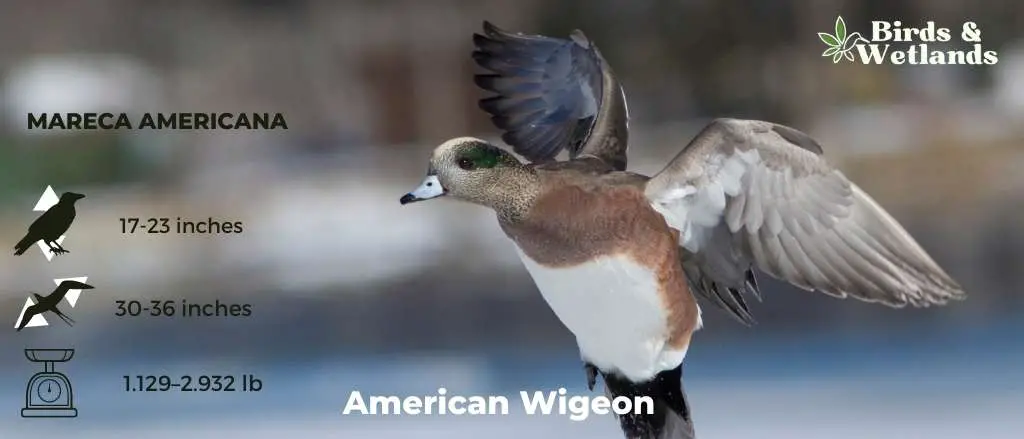
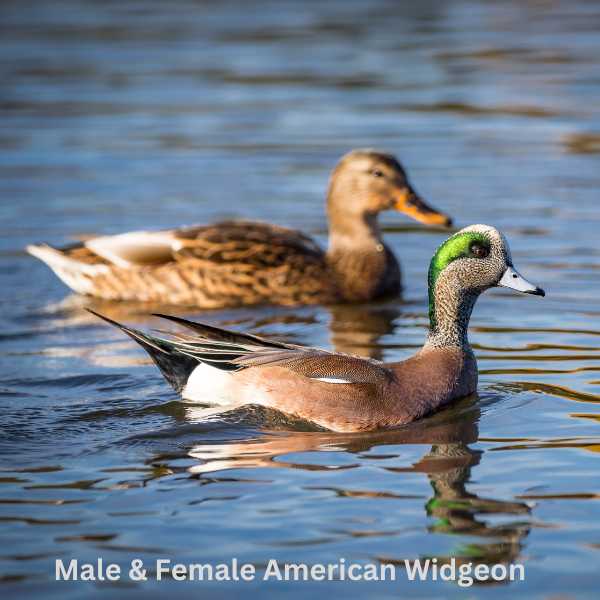
Listen to American Wigeon
Scientific Name: Mareca americana
Length: 17–23 in
Wingspan: 30–36 in
Weight: 1 –3 lb
The American Wigeon is a medium-sized duck species that is a popular sight in wetlands, ponds, and lakes and is often seen in mixed flocks with other ducks.
Males of the species are recognized by their distinctive appearance. They sport a unique white forehead and crown, coupled with a green band stretching from the eye to the back of the head. The body is mainly gray with a pinkish hue on the chest. Females are more subdued in color, with primarily gray and brown tones.
Diet: comprising mainly plant material like aquatic vegetation and grasses, but it also includes insects and other small invertebrates. They are known for a feeding behavior called “kleptoparasitism,” where they often snatch food from other ducks.
American Wigeons usually breed in the northernmost parts of North America. The females create their nests on the ground, often hidden in tall grass near water bodies. They lay a clutch of 6 to 11 eggs which they incubate for about three to four weeks and the ducklings feed on small aquatic invertebrates and aquatic insects.
Osprey (Pandion haliaetus)

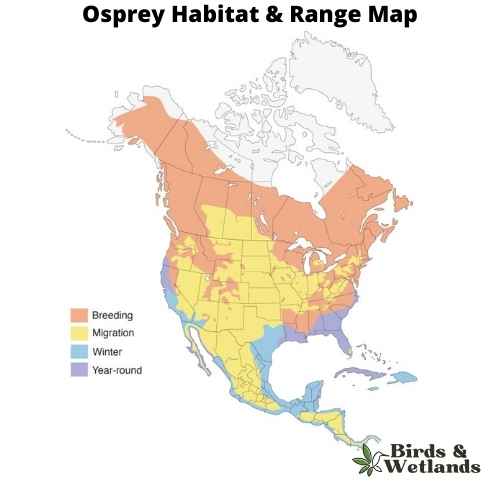
Osprey Sound
Scientific Name: Pandion haliaetus
Length: 50–66 cm (19+1⁄2–26 in)
Wingspan: 127–180 cm (50–71 in)
Weight: 0.9–2.1 kg (2 lb 0 oz – 4 lb 10 oz)
The Osprey, a fascinating bird of prey, is universally known for its exceptional hunting prowess and striking physical characteristics. Osprey are dark brown hawks on the upperparts, contrasting beautifully with the predominantly white underparts, and a distinctive dark band that stretches across the eyes towards the sides of its head.
Equipped with specialized talons and a reversible outer toe, the Osprey’s hunting strategy involves a spectacular plunge-dive into bodies of water, often emerging with a fish securely gripped in its claws.
Found on every continent except Antarctica, the Osprey is a cosmopolitan species favoring habitats near water bodies such as lakes, rivers, and coastal areas, reflecting its piscivorous diet. This bird has a diet almost exclusively of fish, making it a unique member of the raptor family and often referred to as the sea hawk or fish hawk. They locate their prey from the air, often hovering before plunging feet-first to capture a fish. When it comes to breeding, Ospreys are monogamous, often mating for life.
They construct large, bulky nests made of sticks, lined with softer materials, and prefer elevated or isolated areas such as treetops or artificial structures like utility poles. Both parents share the responsibility of incubating the eggs and rearing the chicks.
Common Loon

Listen:
Scientific Name: Gavia immer
Length: 24-39 in
Wingspan: 50-56 in
Weight: 6.4-13.6 lbs
The Common Loon is a large, iconic water bird that can be found in many parts of North America. It is known for its haunting calls, often heard in the early morning or late evening across the region’s lakes and ponds.
Appearance: The Common Loon is celebrated for its striking black-and-white breeding plumage, a red eye, and a robust, black bill. In winter, its plumage turns to a more subdued gray, but its large, sturdy body and pointed bill remain distinctive.
Diet: Common Loons primarily feed on fish, but also consume crustaceans, frogs, and aquatic insects. They are expert divers, capable of plunging deep underwater to catch their prey, and are often observed popping their heads above water before diving for their next meal.
Reproduction: The Common Loon nests near water, typically on lakes and larger ponds in the northern parts of North America. The female generally lays 1-2 eggs per year in a nest made from vegetation on the ground. Both parents share the responsibility of incubating the eggs and feeding the young.
Pied-billed Grebe
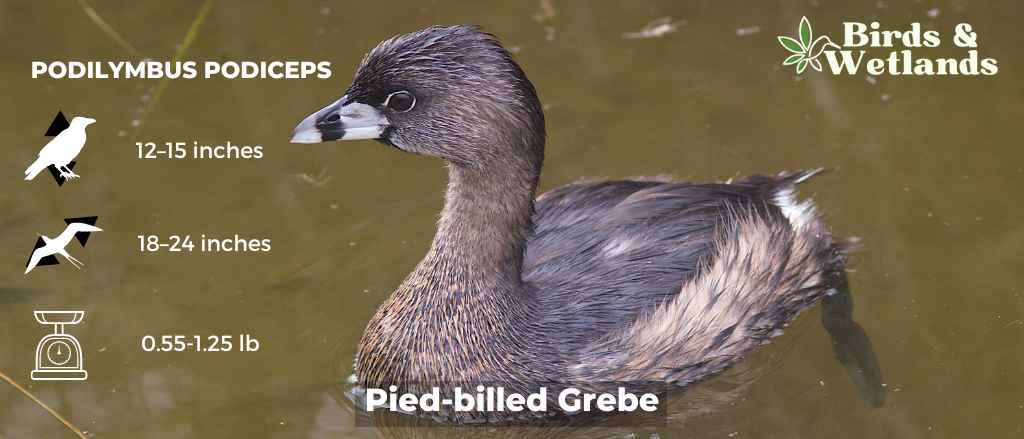
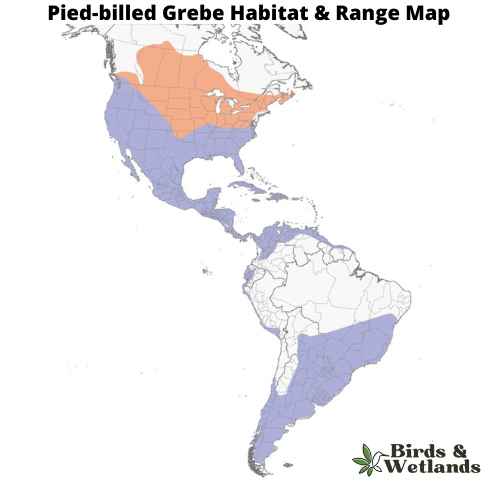
Listen:
Scientific Name: Podilymbus podiceps
Length: 12–15 in
Wingspan: 18–24 in
Weight: 8.9–20.0 oz
The Pied-billed Grebe is a small, elusive water bird well-known for its unique ability to adjust its buoyancy and often “sink” out of sight. It can be found in a wide variety of wetland habitats across the United States.
Appearance: Pied-billed Grebes have a stocky build with a short neck and a chicken-like bill that is conspicuously ringed in black during the breeding season – hence the name “pied-billed”. Their plumage is primarily a muted brown, which can vary in tone depending on the season.
Diet: Their diet consists predominantly of aquatic invertebrates, small fish, and amphibians. Pied-billed Grebes are adept divers and can stay underwater for impressive lengths of time to catch their prey.
Reproduction: Pied-billed Grebes usually nest in dense marsh vegetation, where the female lays 5 to 7 eggs. Both parents share responsibilities for incubation. After hatching, the chicks are often seen riding on their parents’ backs while they learn to navigate their aquatic world.
American Bittern (Botaurus lentiginosus)

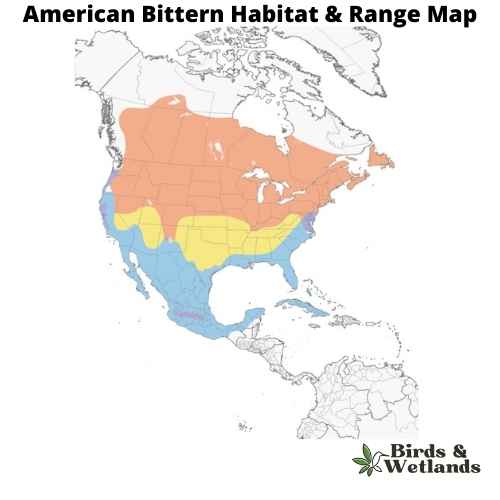
Listen
Scientific Name: Botaurus lentiginosus
Length: 23–33 in
Wingspan: 36–45 in
Weight: 0.816–2.363 lb
The American Bittern is a wading bird, often seen in North American wetlands, known for its exceptional camouflage and unique booming call.
Appearance: American Bitterns are medium-sized birds, with a stocky body, a thick neck, and relatively long legs. Their plumage is brown and heavily streaked with a variety of shades, making it an excellent camouflage against marshy vegetation. Their eyes are yellow, and they have a pointed yellow bill.
Diet: These secretive birds are carnivorous, feeding mostly on fish, but also on insects, amphibians, and small mammals. They hunt by standing still and waiting for prey to come within striking distance, then rapidly lunging forward with their long necks to seize the prey.
Reproduction: American Bitterns nest in dense wetland vegetation, often quite close to the water. The female lays a clutch of 2 to 7 eggs, and she is solely responsible for incubation and caring for the young.
Marbled Murrelet (Brachyramphus marmoratus)
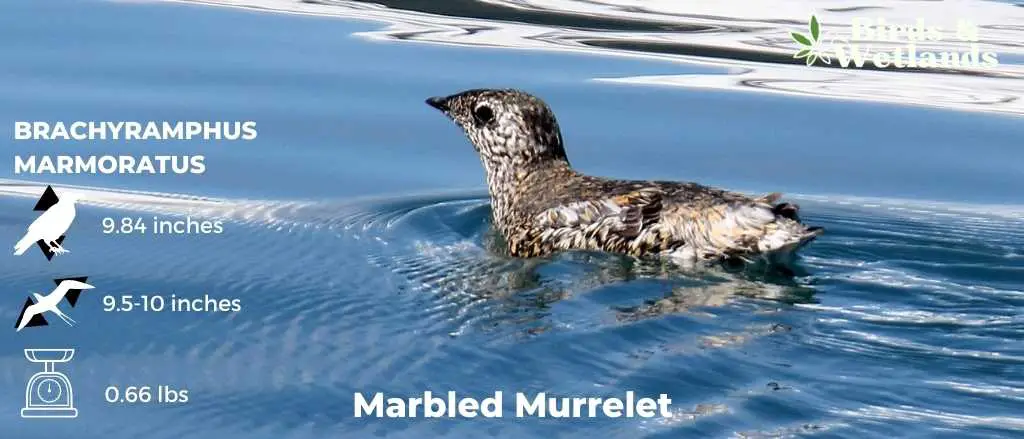
The marbled murrelet is a small seabird that nests in old-growth forests on the Pacific coast of North America. It’s a member of the Alcidae family, which also includes puffins, guillemots, and murres.
- Scientific Name: Brachyramphus marmoratus
- Length: 25 cm
- Wingspan: 9.5 to 10 inches (24 to 25 centimeters)
- Weight: 10.5 ounces (300 grams)
Marbled Murrelet Description
It has dark brown feathers with a white belly, and its wings are black and white. They have a long bill that curves down at the tip, which helps them catch fish. The Marbled Murrelet has thick legs for wading in water.
Marbled Murrelet Sound
Marbled Murrelet Habitat & Range
The marbled murrelet is found along the Pacific coast of North America in Alaska to southern California.

Marbled Murrelet Diet
The marbled murrelet feeds on small fish such as capelin, sand lance, anchovy, herring, smelt, salmon fry and juvenile rockfish along rocky coasts during breeding season. During migration and winter months they eat small invertebrates such as krill and squid near the surface of open water.
Marbled Murrelet Nesting
They will build their nest on the ground under trees or shrubs, or sometimes on grassy slopes of hillsides. They inhabit old-growth forests where they build nests out of mosses and bark strips on branches high above the ground. They have been known to nest as far inland as 2 kilometers from the ocean.
The average clutch size for this species is two eggs, though it can be anywhere from one to five depending on how many days are available for laying eggs due to seasonal influences such as weather patterns or food availability (which affects timing).
The population size for this species is unknown due to its limited range and habitat, but it is believed that there are fewer than 50 breeding pairs left in existence.
Where to Spot Washington’s Water Birds
Nisqually National Wildlife Refuge, Olympia: A major stopover for birds migrating along the Pacific Flyway, this refuge offers the chance to see a diverse range of water birds such as Northern Pintails, American Wigeons, and Great Blue Herons.
Billy Frank Jr. Nisqually National Wildlife Refuge, Olympia: This large estuary restoration project has attracted many species of waterfowl, shorebirds, and songbirds, making it an ideal location for birdwatching.
Ridgefield National Wildlife Refuge, Ridgefield: A major wintering area for the dusky Canada goose, this refuge is also home to a large variety of other water birds like the Great Blue Heron, American Bittern, and many species of ducks.
Conboy Lake National Wildlife Refuge, Glenwood: A haven for waterfowl and shorebirds, the refuge offers the chance to see Sandhill Cranes, Mallards, and Canada Geese among others.
Ocean Shores: This coastal city’s beaches, particularly the area around the North Jetty, offer opportunities to see a variety of seabirds and shorebirds, including gulls, terns, pelicans, and sandpipers.
| Neighboring State | Best Spots for Birdwatching |
|---|---|
| Montana Water Birds | Bowdoin National Wildlife Refuge, Benton Lake National Wildlife Refuge, Ninepipe National Wildlife Refuge |
| South Dakota Water Birds | Sand Lake National Wildlife Refuge, LaCreek National Wildlife Refuge, Waubay National Wildlife Refuge |
| Nebraska Water Birds | Crescent Lake National Wildlife Refuge, DeSoto National Wildlife Refuge, Fort Niobrara National Wildlife Refuge |
| Colorado Water Birds | Alamosa National Wildlife Refuge, Monte Vista National Wildlife Refuge, Barr Lake State Park |
| Utah Water Birds | Bear River Migratory Bird Refuge, Great Salt Lake Shorelands Preserve, Fish Springs National Wildlife Refuge |
| Idaho Water Birds | Deer Flat National Wildlife Refuge, Minidoka National Wildlife Refuge, Coeur d’Alene River Wildlife Management Area |
FAQS About Waterbirds in Washington
What is the black water bird in Puget Sound?
One prominent black water bird commonly found in Puget Sound is the Double-crested Cormorant. This bird is characterized by its black plumage, long neck, and a hooked bill. It’s often seen perched with its wings spread out to dry after diving for fish.
What is a black water bird in Washington state?
In Washington state, the American Coot is another black water bird frequently observed. Although often mistaken for a duck, the American Coot has a distinct white bill and is more closely related to sandhill cranes. They are often seen in freshwater habitats, paddling around and diving for aquatic vegetation.
What are the black birds in the water in Seattle?
In Seattle, especially around areas like Lake Union and Lake Washington, one can often see Double-crested Cormorants and American Coots. Both these black birds are commonly found in the water, diving for food or swimming. The cormorants, in particular, are easily recognizable when they perch with wings spread to dry after a dive.
In Washington, the Fish and Wildlife Service oversees the protection of multiple species, including fish-eating birds and marine birds. Turnbull National Wildlife Refuge is a sanctuary for seven species of marine birds, among which are those with chestnut brown heads and black and white tails. The green-winged teal, recognized by its distinct coloring, thrives here. These birds rely on the marine habitats of the state, where diverse prey species sustain them.

